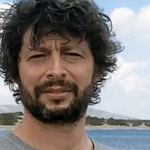The Middle reaches of the Fengkang River, Daren Township, Taitung County, Taiwan
36th place in Biotope Aquarium Design Contest 2017
![]() Taiwan. Newt Jhuang
Taiwan. Newt Jhuang

Volume: 324 L
Dimensions: 120x60x45 cm
List of fishes: Sicyopus zosterophorus, Sicyopterus japonicus, Sicyopterus lagocephalus, Stiphodon percnopterygionus, Stiphodon atropurpureus,Candidia pingtungensis, Caridina multidentata, Caridina faciata, Septaria porcellana
List of plants: Pteris vittata
Description of decorations: Rocks, pebbles, small rocks, and sends
Description of equipment: Chiller control at 23℃、flow pump 3500L/H、flow pump 2439L/H、LED lamps 35.7W, 3717Lm
Water parameters: Temperature is 23℃, pH is 7.5
Description of the area surrounding the biotope: Fengkang River is a small, independent stream located in Taiwan’s south-east. Fengkang River is characterized by its small catchment area. With its short length and low volume of water flow, Fengkang River has seen its water being cut off during withered water period. Valleys in this region are small and narrow, making it unsuitable for human habitat and farming development, rivers in the region are covered with dense forestry and seldom see pollution. Furthermore, with the lack of land-locked fish, Fengkang River has become a haven for fish migration. Kuroshio Current, an ocean current on the west side of the North Pacific Ocean, begins off the east coast of the Philippines, passes through Taiwan’s east coast, before flowing northeastward past Japan. Not only does this ocean current bring warm waters from the tropics to Taiwan and Japan, it also brings migrating fish, making species in Fengkang River abundant.
Description of the underwater landscape of the biotope: Small and independent river usually have water cut off during withered water periods; therefore it is usually composed of rocks, stones, and sand, instead of water plants.
Description of the parameters of the habitat: Temperature is 23-26℃, pH is 7.9-9.0
List of fishes: Include Sicyopterus japonicus, Sicyopterus lagocephalus, Sicyopterus longifilis, Sicyopus zosterophorus, Sicyopus auxilimentus,Smilosicyopus leprurus, Stiphodon atropurpureus, Stiphodon elegans, Stiphodon pelewensis, Stiphodon percnopterygionus, Stiphodon imperiorientis, Stiphodon surrufus, Stiphodon alcedo, Lentipes armatus, Rhinogobius gigas, Anguillidae, Candidia pingtungensis, Kuhlia rupestris, Hippichthys, Microphis, Caridina multidentata,Caridina faciata, Caridina weberi, Atyopsis spinipes, Australatya obscura, Septaria porcellana et al.
List of plants: It lacks water plants. Composed mainly of algae. Bryophyte and fern such as Pteris and Lygodium japonicum, etc can often be seen next to water.
Threats to the ecology of the biotope:Caridina multidentata, Blue Neon Goby and Septaria porcellana are often caught for commercial purposes such as Aquarium creatures. As igrating species, they also face the threat of destruction and pollution of their habitats, causing their numbers to decrease.
Sources of information:
- https://www.facebook.com/100000115283878/videos/vb.100000115283878/1950218431658647/?type=2&theater
- https://www.facebook.com/100000115283878/videos/vb.100000115283878/1909100969103727/?type=2&theater
- https://www.facebook.com/100000115283878/videos/vb.100000115283878/1947654748581682/?type=2&theater
- https://www.facebook.com/100000115283878/videos/vb.100000115283878/1888254791188345/?type=2&theater
- https://www.facebook.com/100000115283878/videos/vb.100000115283878/1888320654515092/?type=2&theater
- https://www.facebook.com/100000115283878/videos/vb.100000115283878/1466302140050281/?type=2&theater
- https://www.facebook.com/100000115283878/videos/vb.100000115283878/1840563779290780/?type=2&theater ,
- https://data.gov.tw/dataset/35380
- http://mk00.pixnet.net/blog/post/341644194-%E5%B0%8B%E6%89%BE%E9%BB%91%E9%B0%AD%E6%9E%9D%E7%89%99%E9%B0%95%E8%99%8E%28-stiphodon-percnopterygionus-%29
- Book: Da-Qing Zhang, Wei-Chieh Tseng(2014). Goby Pedia. Ming-tai Zhou, Yui-Ching Kao(2011). The Freshwater and estuarine oh Taiwan.
Comments of the members of the jury of Biotope Aquarium Design Contest 2017

This aquarium is holding one of the most natural looking bottoms in this contest. The species you keep in your aquarium is really interesting. The combination of base and light resembles a real underwater view of the river. The algaeing of a part of the rocks was very important in terms of giving us a natural and realistic image. Volume and number of fish are also very good determined. Congratulations.

Low water level is a plus when you create fast flowing stream or river. I see that there is a chiller and additional stream pump which is also additional benefit for the biotope and the fish from high flow waters. The bottom is created naturally with pebbles and round rocks that are like in nature.
It is a perfect imitation of a fast-flowing stream. Stones of various sizes, arranged in a chaotic, yet optically very nicely balanced way, shallow water, and strong current. In my opinion the only drawback is that the real amount of water might be slightly too small for all the inhabitants, the tank itself has, indeed, 324 litres, but it is filled to about half of its height, so only about 144 litres, from which the volume of the stones has to be subtracted as well. But all the animals seem to be thriving, so the overall impression is very good.

It is a biotope of a small river with a rapid current without higher vegetation. There are many such rivers in Taiwan. It can be seen that the author of the entry studied this river personally and recreated its exact copy, which confirms: please set up biotopes that were researched by you personally.

While it may not be the prettiest biotope, this work more than compensates with its incredible authenticity. Nothing in the close-up shots betrays that you observing an aquarium, and not snorkelling in the middle of a stream. The careful selection and arrangement of the rounded river stones mimic the natural sorting and erosion that occurs in fast flowing streams, with smaller stones filling the spaces between the larger ones. Aufwuchs layers cover the rock, just as in the wild, providing food for the snails, shrimp, and gobies. A swift, turbulent current provides the perfect conditions for a school of Horse Mouths to school against the flow. The light plays over the bottom reflecting the ripples. Limpet-like snails adapted to keep a low profile glide over the stones, grazing while various gobies perch from their territorial mounts. In sheltered spots, shrimp gather to process bits of debris that have settled in the cracks and pick at the algae layer. The entire situation is so natural that all the inhabitants simply settle into their pre-adapted niches, seemingly none the wiser that they are not in the middle of a stream in Taiwan.

It is a surprisingly realistic biotope. A real immersion in a natural water body! Stones are located chaotically in a natural way and simultaneously harmoniously. LED lighting, creating underwater glare, and a powerful flow pump enhance the effect. The stones are moderately covered with algae – just enough to create the effect of a sunny stream, and not a dirty aquarium. The life of the inhabitants of this aquarium is fascinating. A world that is interesting to watch – you will not come off. In the right corner you can see the wires from the equipment, but this does not spoil the overall impression of the work, since they are in the above-water part. This aquarium could be a visual aid for studying biotopes of Taiwan. I support several entries of this contest, but this aquarium is one of my main favourites.
